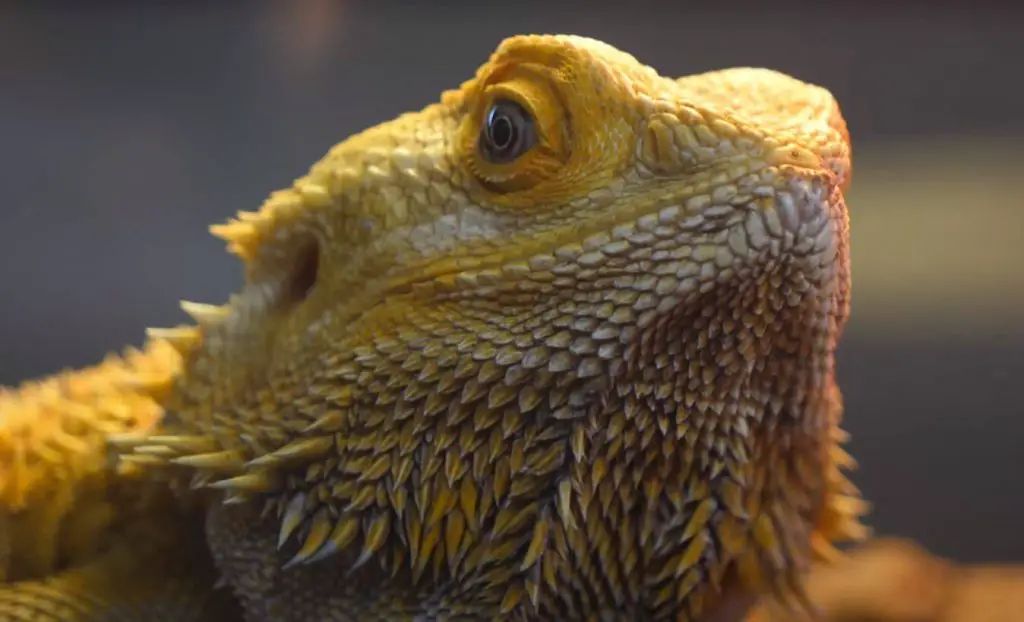“How can you tell if your bearded dragon is happy?” That is a question that many people intending to raise bearded dragons are wondering about.
Just like humans, these bearded dragon babies also have times of stress and you need to know the necessary ways to take care of and protect them.
This bearded dragon breed has the same emotions as humans, and they also need to be properly loved and cared for.
To tell if your bearded dragon is happy as well as to keep them always healthy and happy, read the guidelines below!
Related Posts:
- Can Beardies Eat Pears?
- Signs of MBD in Beardies
- How to Pick Up a Beardie?
- Beardie Brumation or Dead: How to Differentiate?
- Why Is My Beardie Breathing Heavy?
- Why Is My Beardie Closing Eyes When Stroked?
How to Tell If Your Bearded Dragon Is Happy?
How to tell if a bearded dragon is happy?
A happy bearded dragon often displays bright and alert behavior. They’ll be active, exploring their enclosure, basking under their heat lamp, and readily consuming their food.
They will have vibrant coloring and smooth skin. They may also show curiosity towards their surroundings and may interact with their owner through gentle approaches and a lack of aggressive behavior.
If your bearded dragon isn’t showing any of these signs, they may be dealing with some emotional or health issues caused by his environment.
How to Make a Bearded Dragon Happy?
To make bearded dragons happy, you can do the following things to improve their mood:
1. Arrange the Cage
When you first start raising your pet, you should choose baby bearded dragons with a small size.
To give your baby the best environment, you should invest in a glass cabinet.
This type of cage will help keep them from suffering from common petty diseases.
The barn plays a very important role in the development of the baby dragon. It also determines his lifespan.
An indispensable thing in the cage is to arrange 3 bulbs: 1 UVA bulb and 2 UVB bulbs. UVA bulb has a heating effect on them.
Used to create solar effects, this bulb will help develop bones with UVB light. Because bearded dragons need great sunlight, they need 2 balls in a cage.
UVA lights are lit for 1 to 2 hours a day before feeding them to digest the rest of the previous meal.
This bulb helps your bearded dragon digest faster. UVB lamps are lit 8 to 10 hours a day starting from 8 am to 5 pm.
Note that the lights will not be turned on at night because they also need time to sleep.
“How can you tell if your bearded dragon is happy?” If they have good digestion and adequate sleep, they are happy!
Here are a few bulb suggestions for you:
- Zoo Med Repti Basking Spot Bulb, 100 watts
- Mega-Ray Mercury Vapor Bulb
- Zoo Med Bearded Dragon Lamp Combo Pack
With artificial breeding conditions, you should also ensure the temperature of the outside environment is 30-35 degrees for your bearded dragon to grow up quickly.
A little trick that allows your dragon to heat and digest is to put a stone or a brick under the floor opposite the UVA bulb.
With this design, the stone will heat up when heated under the lights, so that they keep the abdomen warm.
This is because, with a good environment, your lizard can be healthy and grow well.
2. Clean the Cage

Only when living in a clean environment can beardies live healthy and happy.
Although bearded dragons are a desert species, you should also leave one tray of water when arranging in the cage.
This water tray will allow them to bathe and easily peel their skin in case of a lack of water, which is also the fastest way to rehydrate them.
The lining of the newspaper makes the cage very easy to clean.
You just need to take the newspaper pads out of the cage and replace them with another one, which saves costs and protects the environment.
After cleaning the cage, you turn on the UVA hot spotlight for the bearded dragon to heat.
3. Feed Them Properly
Bearded dragons’ food is varied and plentiful. However, depending on their size and age, “salty” and “vegetarian” are suitable.
If your bearded dragon seems to be enjoying the food, that is one way to tell if your bearded dragon is happy.
a. Insects
For baby bearded dragons, you can feed them rice worms, and remember not to pour rice worms into the cage because they will bite and kill baby beardies.
You should pay attention to some situations when your baby stops eating, and remove leftovers. Do not leave them on the lining surface.
Adult bearded dragons usually measure 20 cm or more. You can feed them crickets, pinky mice, and superworms. The maximum size of white mice and centipedes you can feed bearded dragons is less than 40 cm.
b. Vegetables and Fruits
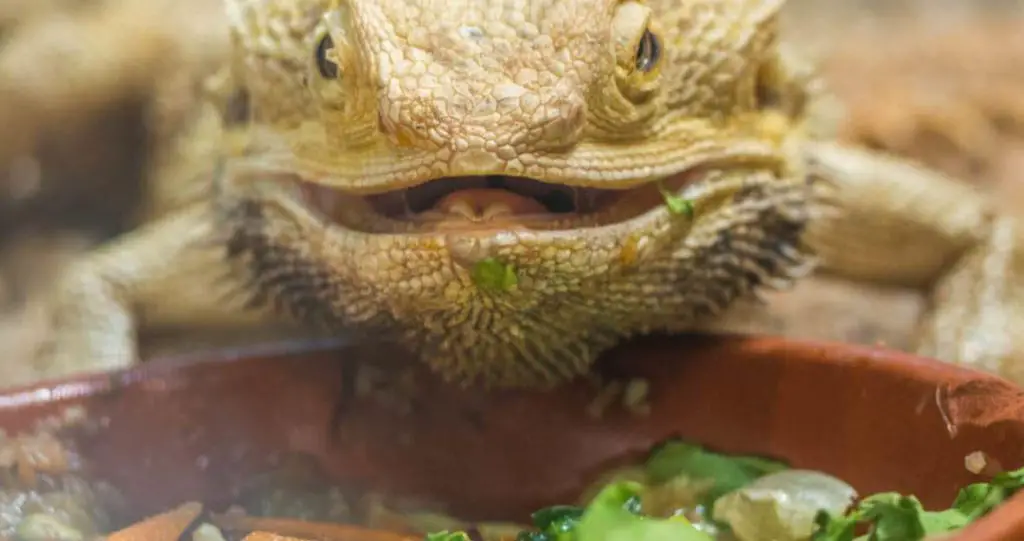
It is salty food and this is a vegetarian part. Bearded dragons can eat a variety of vegetables and fruits.
Choy sum is one of the top choices for vegetables because they contain a lot of calcium. You can also feed them fruits such as apple, and strawberry grapes.
One day old food must be eliminated if your pet does not finish, then replace it with new food the next day because eating old food will cause intestinal bacterial disease.
Fruit and vegetable foods should also be thoroughly washed before feeding them to avoid dangerous pesticide poisoning.
A bearded dragon’s mood is very much dependent on food. So, remember to vary the food menu to add all the necessary nutrients to help them grow well.
Related Posts:
How to Know If a Bearded Dragon Is Not Happy?
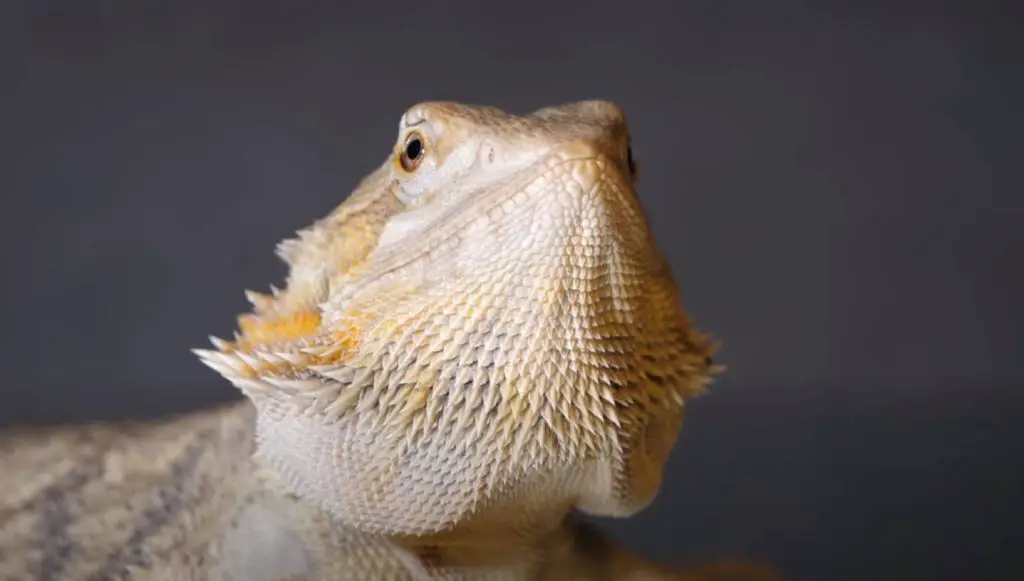
How to know if your bearded dragon is not happy?
Your pet suddenly started scratching the glass tank.
They are apathetic and anorexic, with strange black spots appearing on the abdomen and many other places.
That is most likely a sign that he is stressed.
You need to have a proper diagnosis in order to be able to treat them.
What Makes a Bearded Dragon Unhappy?
Here are some reasons why bearded dragons are unhappy:
- Loud noise, especially when there is no private care room or cage when they are kept indoors.
- A stranger approaches their cage.
- Hygiene and handling them too much, especially in the beginning.
- Having other pets or being bullied by other children in the cage.
- The temperature in the tank is very low or very high.
- High humidity.
- No food, or feeding inappropriate food.
- The tank is too small. Change the cage and the decorations.
- Their cages have been moved.
- The habitat around changes too frequently (more than 1 time in 3 months).
- Lighting in the tank or the room is too bright.
- Someone hits the glass.
- Crustaceans of insects (mainly crickets) in the tank for too long.
- The owner is boring or lacks interest.
- Dirty tanks. Their stables should be tidy.
What Are the Signs of a Stressed Bearded Dragon?

1. Refuses to Eat and Drink
If your bearded dragon is stressed, this will also affect his appetite and he may not want to eat.
There are other problems that may prevent your dragon from eating.
For example, low temperatures in the tank will interrupt the proper digestion of food, which leads to constipation and indigestion.
However, be aware that your bearded dragon may also refuse food for disliking the taste.
Either they are picky eaters or they are bored with similar foods as they are very picky about what they like.
And you need to diversify their diet for them.
Moreover, you should start supplying green vegetables to your pet as soon as possible.
If only insects are fed, they will become fussy pets.
2. Acts Aggressively
Your pet is susceptible to stress if something disturbs him. He will go from gentle to aggressive.
They are also sensitive to sudden movements or strange sounds.
When a male dragon meets another male. They will try to fight, often opening their mouths to wait for each other to bite.
If you have just brought a new bearded dragon, leave him in the tank for 1-2 weeks without any interaction.
Do not disturb him. Also, do not clean, and do not let other pets come near.
You will only have access to food supplies, water changes, and tank cleaning.
After a week, you will begin to feed with your hands.
And it is possible to stroke him, but after he has stabilized, you can start cleaning or handling.
3. Moves Slowly
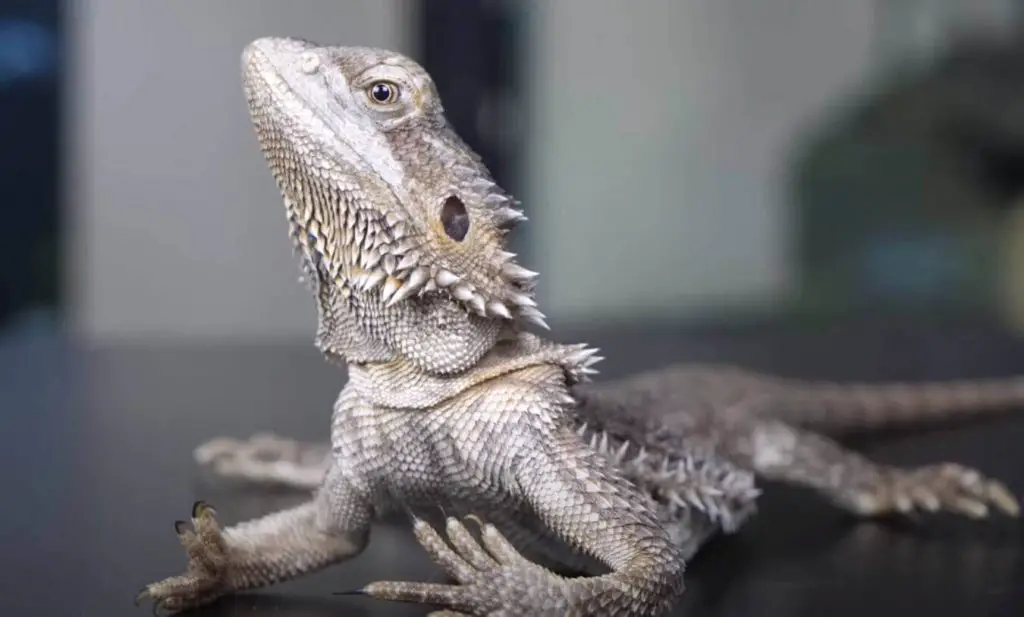
If your bearded dragon acts lethargic and doesn’t move much, he gets stressed.
This could be due to the wrong tank setting (wrong lighting, temperature, or humidity) or the wrong diet, dehydration, illness, and more.
4. Scratches or Strokes the Glass
In some cases, the owner may know his bearded dragon is trying to get out. If you often take him outside to play, he will scratch the glass wall to get out when he is bored.
But if it’s not for this, it’s probably due to the high temperatures.
You should check the temperature in the tank (both hottest and coolest).
If your bearded dragon is scratching or running frantically, he may be hot.
The lights are very bright, causing them to see their own reflection, which can also cause this reaction.
Or if your bearded dragon is having a baby, it could be a sign of the preparation to spawn.
5. Appearance of Stress Marks
The colors of happy bearded dragons are usually orange, white, or blue.
If your pet shows dark spots in the beard, he may be under stress.
Beard dragons may have ‘stress marks’ if they are stressed. These marks can be oval lines.
You can find these marks mostly on the abdomen. But it can also be on limbs or antennae.
If a baby appears with stress marks, this may be due to the wrong setting (lamp, temperature, humidity).
Or tank size, diet, tankmates, or any other external reasons.
These marks only go away when you adjust to make them reassuring. Pay attention to these details to make your dragon happy
How to Make a Stressed Bearded Dragon Happy?
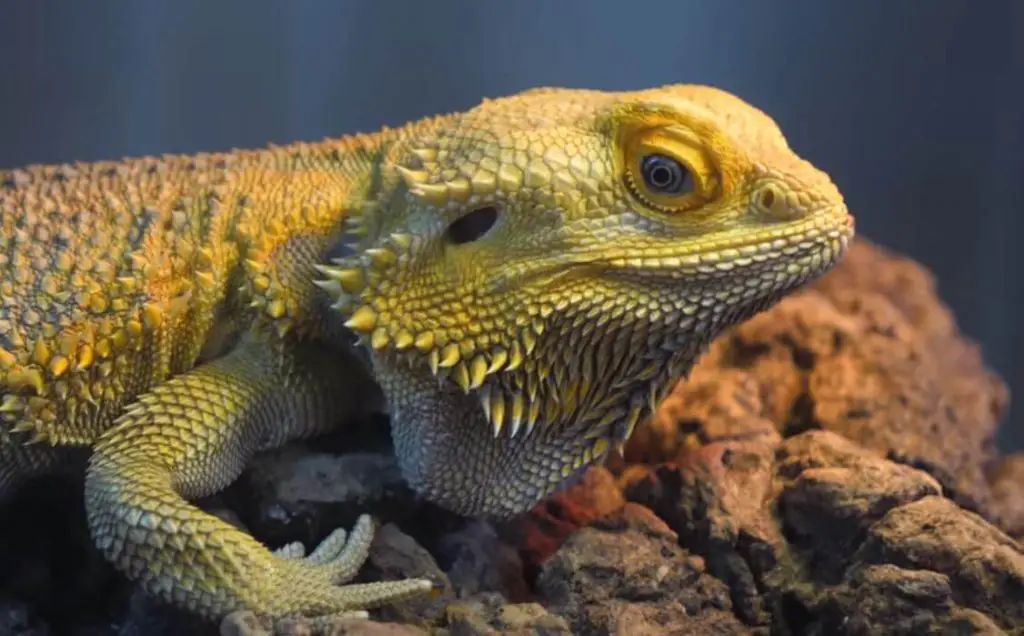
1. When Relocating the Cage
After being moved, beardies will always be in a state of fear and stress.
If you want your bearded dragon to be happy, you should give him more time to adapt to his new environment.
During the first few weeks, avoidance, refusal to eat, lethargy, and similar behaviors are common but not for long.
Patience and persistence are essential, especially for the first time your pet moves to another cage.
They can be quite aggressive and startle from time to time.
Give your bearded dragon a comfortable space with a week of solitary.
Then approach his tank slowly, feed him, and change the water.
You can also start putting your hands in the tank and try to pet them if he feels okay.
You can even add your personal belongings to the tank so that their owner smells familiar.
Read More:
2. When the Bearded Dragon Suddenly Gets Stressed
It is important for you to find out the most accurate reason why he is stressed.
If he is with another friend in the cage, then separate them.
If the tank is empty, add some accessories. Make sure they have a place to sit and make sure there’s a shelter.
A rich environment is important.
Bearded dragons are curious, but at the same time may be afraid of other pets or the outside world.
You can also give your pet a bath to help him relax.
Not all bearded dragons love to soak, but most of them love to bathe.
You should observe and give reasonable plans for your bearded dragon to always feel happy.
Frequently Questions About Bearded Dragon’s Happiness
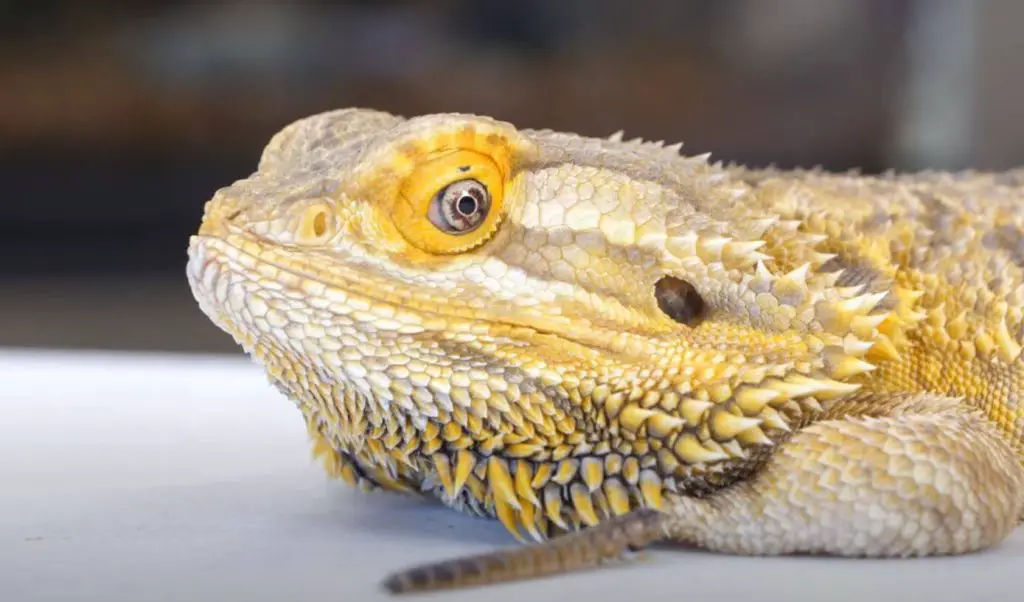
1. How to Distinguish Male Bearded Dragons From Females?
Males usually have larger heads than females and have longer spines.
Males usually have 2 small marbles under their tails. Females don’t have this marble.
2. Are Bearded Dragons Kept With Cats and Dogs?
Will your bearded dragon be happy if it is with a dog or a cat? The answer is no.
Cats and dogs will eliminate him immediately.
Even when the sun is dry, remember to observe the sky. Because in areas such as hills and mountains, there are often birds and eagles.
It will go down, so you need to pay attention to sun drying and making net pens when drying.
3. Do Bearded Dragons Lay Eggs?
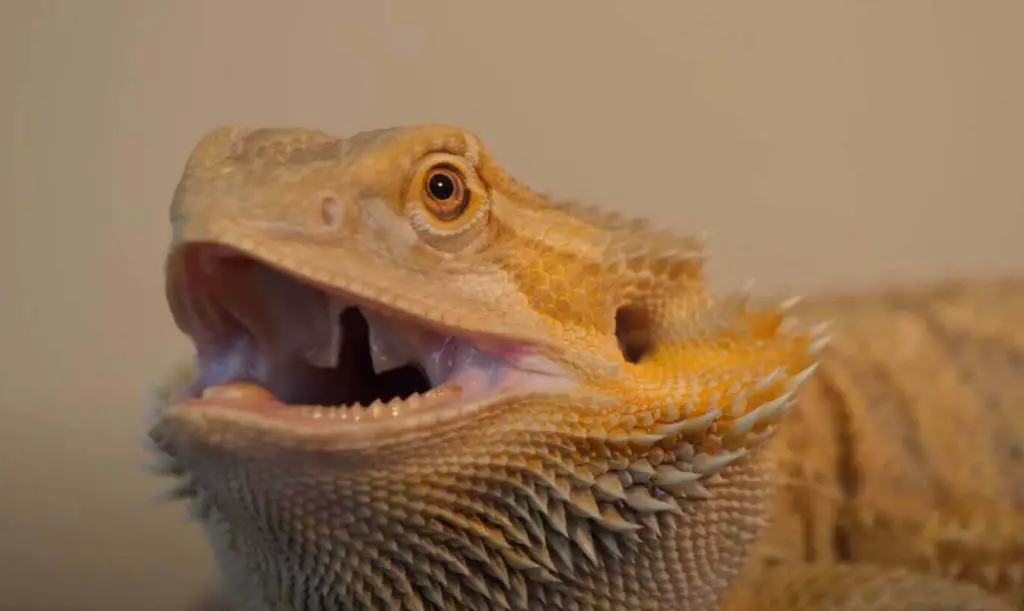
Just like their reptile relatives such as lizards, salamanders, lizards, and turtles, the bearded dragon also lays eggs.
During mating, the male will bite on the female’s neck. If it bites too hard, it bleeds. You should remove it. After having sex, the male may be tired.
Increase calcium for children because, during pregnancy, weaning children need a lot of calcium.
4. What Needs to Be Prepared for the Laying of the Female Eggs?
If the female is successfully fertilized, they will lay eggs within 6 weeks.
Therefore, you need to prepare a box to incubate eggs.
The best substrate to use is a mixture of soil and sand, for every 2cm you put down 1 egg.
And remember that when picking up eggs, you must pay attention to keeping the egg shape while lying on the floor.
Bury the eggs about the depth of the egg into the mixture.
The female can lay 15-40 eggs, and the incubation temperature of the eggs ranges from 27 degrees C to 30 degrees C.
After about 74 days, the eggs will hatch.
5. How Do Bearded Dragons Show Affection?
You really want your bearded dragons to love you in the same way you love and care for them. This is also very easy to spot.
If a bearded dragon starts to lick the air as you approach him, this is a sign he is happy to see you.
6. Do Bearded Dragons Like Music?
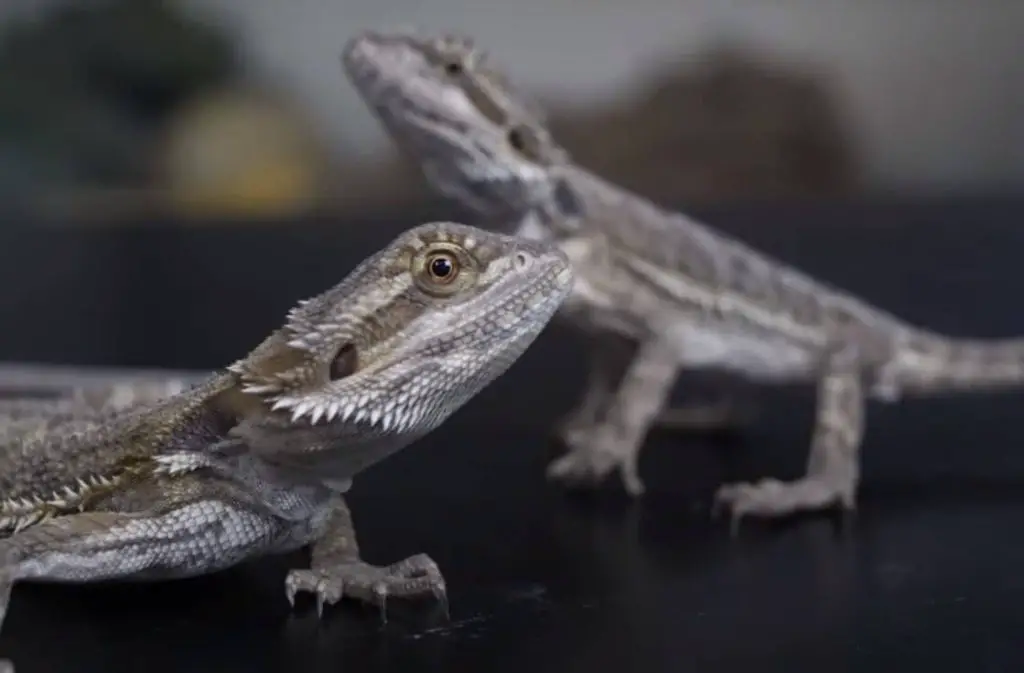
The answer is they often feel relaxed when listening to music.
Just like humans, your bearded dragon needs relaxation, especially when he’s stressed.
Music is a great way to relieve stress in your bearded dragon.
In addition to feeding and heating them, you should also let them listen to music at certain times of the day.
This is great for their development.
You also need to choose the genres of music they love to play.
7. Do Bearded Dragons Like to Swim?
The answer is, bearded dragons enjoy swimming.
To create the perfect pool for your bearded dragon, it is very easy to prepare a tank or pot twice the size of the bearded dragon.
Dragons love to swim in the water because they can entertain and provide water at the same time.
Read More:
8. Why Does My Bearded Dragon Stare at Me?
Bearded dragons stare to stay safe and as an instinctive behavior to learn about their surroundings.
They often stare at you when you approach. Don’t worry!
Conclusion
We hope that this article has helped you answer the question, “How can you tell if your bearded dragon is happy?”
In order for your bearded dragons to always be healthy and happy, please take note of the important things we mentioned when raising them!
Wish you success and please always follow our articles for more useful sharing for you.
Further Reading:
- Carolina Custom Cages Terrarium Review
- 8 Best Basking Rocks for Beardie: What Is the Best Choice?
- 10 Best Thermometers for Beardie: How to Choose the Best One?
- 5 Best Beardie Lighting Setups for Beardie Lovers
- 9 Best Heat Lamps for Beardie: Natural Habitat Provided

